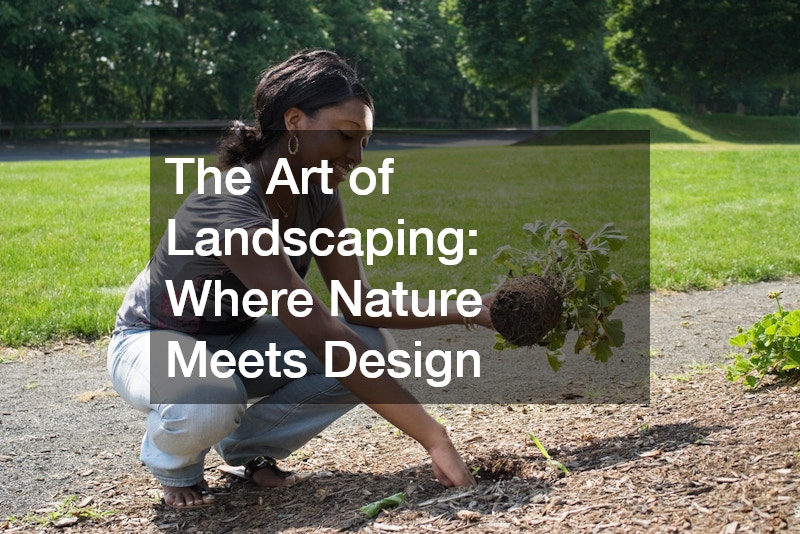Discover the intricate balance between nature and design as we explore the captivating world of landscaping. This art form not only enhances aesthetic appeal but also promotes ecological harmony and sustainable practices. By integrating natural elements with design principles, landscaping transforms outdoor spaces into functional and visually appealing environments.
The Key Principles of Landscape Design
Unity and Balance
Unity and balance are pivotal in creating a cohesive and aesthetically pleasing landscape. Through the strategic use of repetition, color schemes, and texture, designers ensure that all elements of a landscape work together harmoniously. By achieving unity, landscapes not only become visually cohesive but also evoke a sense of tranquility and order.
Balance, on the other hand, involves the distribution of visual weight within the landscape. A well-balanced landscape can be symmetrical, with equal visual weight on either side of a central axis, or asymmetrical, where balance is achieved through the strategic placement and sizing of different elements. This principle ensures that landscapes feel stable and grounded, promoting a natural flow that draws the eye across the space.
The integration of both unity and balance can transform a banal garden into a mesmerizing work of art. For instance, the choice to use a consistent color palette throughout can unite various features. Additionally, the placement of a small group of trees on one side of a garden may be balanced by a larger, uniquely shaped boulder on the opposite side.
Proportion and Scale
Proportion and scale directly impact the visual harmony and functionality of a landscape design. Proper proportion ensures that landscape features relate seamlessly to each other and the overall setting. This means selecting plant sizes that match the dimensions of the space and structures that fit harmoniously within their environment.
Scale refers to the comparative size of an object in relation to its surroundings. When designers skillfully apply scale, they make outdoor spaces feel appropriately sized and comfortable. For example, a small garden would benefit from low, delicate plants instead of towering trees that would dwarf the space.
Successful landscape design considers both human and natural scale, blending hardscapes and plantings into a unified whole. For instance, a backyard may feature a large pergola, proportioned to complement the adjacent towering trees, simultaneously offering shelter and anchoring the design. These considerations of proportion and scale help maintain a balance between human interaction with the space and the vastness of nature.
How Landscaping Contributes to Sustainability
Eco-friendly Practices
Landscaping can significantly contribute to sustainability by adopting eco-friendly practices. One critical aspect is water conservation, achievable through water-efficient irrigation systems such as drip irrigation and rainwater harvesting. These systems ensure that water is used judiciously, reducing waste and preserving vital resources.
Another sustainable approach is the selection of native plants in landscaping design. Native plants are adapted to the local climate and soil conditions, requiring less water and fewer chemical inputs such as fertilizers and pesticides. By choosing these plants, the need for intensive maintenance decreases, leading to a healthier and more sustainable garden.
Biodiversity in Landscaping
Biodiversity is essential for creating resilient and dynamic landscapes. By incorporating a diverse range of plant species, landscapes become more adaptable to changes in climate and disease pressures. Such diversity provides habitats and food sources for various wildlife, including birds, insects, and small mammals, encouraging ecological balance.
The incorporation of biodiversity into landscaping fosters healthy ecosystems that function efficiently and sustainably. Diverse plantings can mitigate soil erosion, improve water filtration, and enhance the carbon sequestration capacity of a landscape. A well-designed landscape, rich in biodiversity, not only enhances visual appeal but also contributes to a myriad of ecological benefits.
The Latest Trends in Modern Landscape Design
Minimalist Aesthetics
Minimalist aesthetics in landscaping emphasize simplicity and clarity, distilling a garden down to its essential elements. This trend often features clean lines, geometric shapes, and a limited color palette to create a sense of calm and deliberation. Elements such as open spaces and gentle transitions are pivotal in achieving a minimalist charm.
This approach not only refreshes the traditional garden layout but also maximizes the functionality of the space. By reducing clutter and focusing on high-impact features, minimalist landscapes feel more expansive and allow each element to be appreciated fully. Additionally, these designs often incorporate sustainable practices, as their simplicity encourages efficiency and reduced resource use.
The minimalist trend often embraces modern materials such as polished concrete, glass, and metal, seamlessly blending nature with contemporary aesthetics. The introduction of sculptural elements and strategically placed statement plants can throw highlights across the streamlined design. Through this approach, minimalist landscaping brings elegance and tranquility to modern outdoor spaces.
Integration of Technology
Modern landscape design is increasingly incorporating advanced technology to enhance both aesthetics and functionality. One notable trend is the use of smart irrigation systems, which monitor environmental conditions to optimize water usage according to plant needs and weather patterns. These systems ensure landscapes are nourished efficiently, conserving water while promoting healthier plant growth.
Technology in landscaping extends into smart lighting solutions, which enhance nighttime ambiance and improve safety. These systems allow for customizable lighting schedules and intensities, bringing landscapes to life after sunset while reducing energy consumption. Integrating connectivity into landscapes adds convenience and adaptability, supporting diverse lifestyle needs.
The art of landscaping continues to evolve as it balances aesthetics, ecology, and functionality. By understanding key design principles, embracing sustainability, and keeping pace with emerging trends, we can create outdoor spaces that are both beautiful and beneficial to the environment. As we move forward, landscaping will play an integral role in shaping sustainable, thriving communities that connect nature with design.

